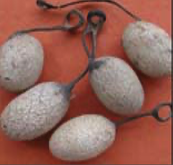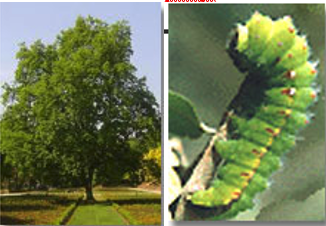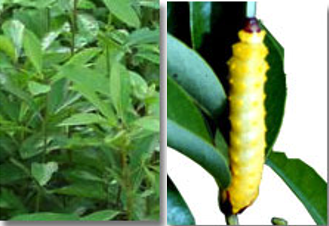🐛 Types of Silkworms
Learn about different types of Silkworms
Which of the following statment is correct?
- There are
five majortypes of silk of commercial importance, obtained from different species of silkworms which in turn feed on a number of food plants. These are:
Mulberry Silk
Bombyx mori, belongs to the family Bombycidae, Lepidoptera.- Although there are several commercial species of silkworms, Bombyx mori is the
most widely used. - It comes from the silkworm, Bombyx mori L. which solely feeds on the leaves of
mulberry plant. - The bulk of the commercial silk produced in the world comes from this variety and often silk generally refers to mulberry silk.
- In India, the major mulberry silk producing States are Karnataka, Andhra Pradesh, Tamil Nadu, West Bengal and Jammu & Kashmir which together accounts for 92 % of country’s total mulberry raw silk production.
- Bombyx mori is native to Northern
China. - Host range: Monophagous, only feeds on
mulberry leaves (Morus alba)while remaining three species are polyphagous in nature. - These silkworms are completely domesticated and reared indoors.
- Mulberry silk has five larval instars (means larva 4 times molts).
- Females of mulberry silk worm have Herold’s gland at the centre of 8th and 9th segment.
- Female pupa is larger and has a ‘X’ mark on the vertical side of 8th abdominal segment.
- Optimum condition for growth of Bombyx mori is 20-28°C, 70-85% RH.
- Except mulberry, other varieties of silks are generally termed as non-mulberry silks.
- Moriculture: Cultivation of mulberry plants is called moriculture (because scientific name of mulberry is ‘Moris alba’).

Explore More 🔭
🟢 https://www.youtube.com/watch?v=tVEsbZbkWf4
Tropical Tasar silk
Antheraea mylitta, Saturnidae, Lepidoptera.Tasar (Tussah)iscopperish/brown colour, coarse silk mainly used for furnishings and interiors.- It is less lustrous than mulberry silk, but has its own feel and appeal.
- Tasar silk is generated by the silkworm, Antheraea mylitta which mainly thrive on the food plants,
Asan(Terminalia tomentosa)Arjun(Terminalia arjuna)Sal(Shorea robusta)- Other: Ber, Zizyphus jujuba,
- Tasar silkworm is bivoltine.
- Tasar silkworm is wild.
- Larva of tasar silkworm spins a ring like structure around the twig and a long peduncle before constructing the cocoon.

- The rearing is conducted in
natureon the trees in the open. - In India, tasar silk is mainly produced in the states of
Jharkhand, Chhattisgarh and Orissa, besides Maharashtra, West Bengal and Andhra Pradesh. - Tasar culture is the main stay for many a
tribalcommunity in India
Oak Tasar Silk
Antheraea proyeli, Saturnidae, Lepidoptera.- It is a finer variety of tasar which feed on natural food plants of
Oak, found in abundance in thesub-Himalayan beltof India covering the states of Manipur, Himachal Pradesh, Uttar Pradesh, Assam, Meghalaya and Jammu & Kashmir. Chinais the major producer of oak tasar in the world and this comes from another silkworm which is known asAntheraea pernyi.- India is the
second largestproducer of tasar silk and the exclusive producer of Indian tasar (also known as tropical tasar), which is largely tended by tribals in the Gondwana belt. - Oak tasar (also known as temperate tasar) is mainly used for furnishing, dress materials and sarees.

Muga Silk
Antheraea assamensis, Saturnidae, Lepidoptera.
- Muga silk is a
golden yellow coloursilk is prerogative of India and the pride of India/Assam state/ Assam silk. Its production is confined to Assam, border areas of neighbouring North-eastern states and Cooch Bihar in West Bengal. - It is the unique
monopolyof India. - It is obtained from
semi-domesticatedmultivoltinesilkworm,Antheraea assamensis. - These silkworms feed on the aromatic leaves of Som (Machilus bombycina) and Soalu (Litsaea polyantha) plants and are reared on trees similar to that of tasar.
- Muga culture is specific to the state of
Assamand an integral part of the tradition and culture of that state. - Assam accounts for more than 95% of the muga silk production.
- The muga silk is a high value product is used in products like sarees, mekhalas, chaddars, etc.

Explore More 🔭
🟢 https://www.youtube.com/watch?v=BqH3O4pq9K8
🟢 https://www.youtube.com/watch?v=-XjlV236RKU
Eri Silk

Philosamia ricinibelongs to the family Saturniidae, Lepidoptera.- Also known as Endi or Errandi, Eri is a multivoltine silk spun from open-ended cocoons, unlike other varieties of silk.
- Eri silk is the product of the domesticated silkworm, Philosamia ricini that feeds mainly on
castor leaves(Ricinus communis) and Kasseru (Heteropanax fragrans). - Eri silk is also called ‘Arandi Silk’.
- Eri silk is non-reelable silk. It is spun.
- In India, this culture is practiced mainly in the north-eastern states and Assam. It is also found in Bihar, West Bengal and Orissa.

- Interestingly, in many parts of the North-East, eri cocoons are produced for their edible pupae and silk is the by-product.
- Elegantly designed eri shawls and chaddars are quite popular because of their thermal properties.
- They can be blended with cotton, wool, jute or even mulberry silk to create exotic fabrics for use in jackets, or suiting material, or for producing a variety of furnishings, making it an interior decorator’s delight.
Classification
- India has the unique distinction of producing all these commercial varieties of silk.
Based on Occurrence
- Except mulberry, other non-mulberry varieties of silks are generally termed as
Vanya SilksorWild Silk. - Vanya Silks includes:
- Tasar (Tropical & Temperate)
- Munga
- Eri
- Vanya sericulture remained obscure for a long time as an exclusive craft of tribal and hill folks inhabiting the
Central and North Eastern India. - It is in the recent past that this tribal tradition assumed importance and attracted attention at National level. The rich production potentialities within the country, steady demand for vanya silk products outside, eco-friendly nature of the production and processing activities, women participation, promoted commercial exploitation of this craft, which culminated in the transformation of this age old tradition to an industry of immense potentiality.
Based on life cycle Per year
Voltinismis a term used in biology to indicate the number of broods or generations of an organism in a year.- The term is most often applied to insects, and is particularly in use in sericulture, where silkworm varieties vary in their voltinism.
- Based on type of voltinism, silkworms are classified into:
Univoltine:Species producing one generation a year.Bivoltine:Species producing two generations a year.Multivoltine:Species producing more than three generations a year. Also known as polyvoltines.- Univoltine race is found in Europe, Kashmir and Punjab and the silk produced is of a
superior qualityand the multivoltine race is found in South India, Assam and Bengal producing an inferior quality of silk.
Morphology

- Mouth parts in Silk Worm: Bitting and Chewing
- Mouth Parts in Silk Moth: Siphoning Type
Malpighian tubulesare the main excretory organ of silkworm larvae.
References
- https://csb.gov.in/
- https://agritech.tnau.ac.in/
- Wikipedia
- https://sericulture.assam.gov.in/
- https://agritech.tnau.ac.in
Which of the following statment is correct?
- There are
five majortypes of silk of commercial importance, obtained from different species of silkworms which in turn feed on a number of food plants. These are:
Mulberry Silk
Bombyx mori, belongs to the family Bombycidae, Lepidoptera.- Although there are several commercial species of silkworms, Bombyx mori is the
most widely used. - It comes from the silkworm, Bombyx mori L. which solely feeds on the leaves of
mulberry plant. - The bulk of the commercial silk produced in the world comes from this variety and often silk generally refers to mulberry silk.
- In India, the major mulberry silk producing States are Karnataka, Andhra Pradesh, Tamil Nadu, West Bengal and Jammu & Kashmir which together accounts for 92 % of country’s total …
Become Successful With AgriDots
Learn the essential skills for getting a seat in the Exam with
🦄 You are a pro member!
Only use this page if purchasing a gift or enterprise account
Plan
Rs
- Unlimited access to PRO courses
- Quizzes with hand-picked meme prizes
- Invite to private Discord chat
- Free Sticker emailed
Lifetime
Rs
1,499
once
- All PRO-tier benefits
- Single payment, lifetime access
- 4,200 bonus xp points
- Next Level
T-shirt shipped worldwide

Yo! You just found a 20% discount using 👉 EASTEREGG

High-quality fitted cotton shirt produced by Next Level Apparel